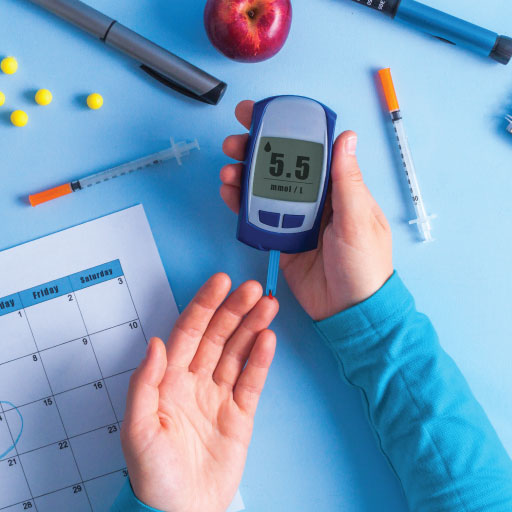Key Takeaways
- A sedentary lifestyle and diabetes are inter-connected. It can lead to insulin resistance, weight gain and slowed metabolism.
- It can cause obesity, diabetes, mental conditions, high BP, lipid disorders, metabolic syndrome and cardiovascular diseases
- Try 30 minutes of brisk walking, HIIT, resistance training, aerobics, stretching and balancing exercises, and doing chores.
Sedentary behavior is increasingly becoming a part of our everyday life. It takes up most of the waking day when individuals sit inactively rather than engage in some activity throughout the day.
What you need to know:
- A sedentary lifestyle can cause diabetes
- What are the negative impacts of a sedentary lifestyle?
- How can people with diabetes stay active?
A sedentary lifestyle can cause diabetes
A sedentary lifestyle can increase the risk of developing type 2 diabetes:
- A sedentary lifestyle can lead to insulin resistance when cells in your muscles, fat, and liver don’t respond well to insulin and cannot easily take up glucose from your blood. As a result, your pancreas makes more insulin to help glucose enter your cells. It can make it harder for the body to regulate blood sugar.
- Being inactive can lead to weight gain, which can also increase the risk of type 2 diabetes.
- Sitting for long periods can slow the metabolism, affecting the body’s ability to regulate blood sugar and blood pressure and break down body fat.
What are the negative impacts of a sedentary lifestyle?
A sedentary lifestyle and physical inactivity are directly proportional to the rise of obesity, diabetes, high blood pressure, lipid disorders, metabolic syndrome (marked by elevated plasma glucose, blood pressure, and waist circumference), and cardiovascular diseases. It can also impact your mental health, causing depression or anxiety.


Inactivity can impair the body’s ability to control blood sugar levels, regulate blood pressure, and break down fat. Sitting down for long periods can change the body’s metabolism, including insulin resistance, leading to diabetes mellitus. Some examples of passive activities include:
- Watching television for long hours with inactive (non-contracting) muscles,
- Scrolling through social media or watching television while sitting or lying down,
- Eating snacks or meals, which prolongs the duration of your meal, keeping you still in one place for a long time, or
- Going to sleep immediately after having a meal.


How can people with diabetes stay active?
Increased physical activity alongside a healthy diet can reduce the risk of diabetes mellitus and other chronic conditions. Here are some ways in which you can ditch sedentary actions, stay active, and take stock of your health:
- Try 30-60 minutes of brisk walking, which can enhance your immune system and reduce the risk of respiratory illness. You can do this by taking small walk breaks after every meal, getting down a station early and walking back home, or taking the staircase instead of the elevator.
- Exercise daily and interrupt your prolonged sitting hours with bouts of light-intensity physical activities.
- High-intensity interval training (HIIT) promotes a rapid enhancement of skeletal muscle oxidative capacity and glycemic control in adults with type 2 diabetes.
- While resistance training can help build strength and improve body composition and muscle mass, it can assist in minimizing the risk of exercise-induced hypoglycemia in people with type 1 diabetes.
- Aerobics training can increase insulin sensitivity, oxidative enzymes, and lung function.
- Elderly individuals diagnosed with diabetes often face the issue of limited joint mobility, resulting partly from the formation of advanced glycation end products (AGEs), a group of compounds that form when reducing sugars react with proteins, lipids, or nucleic acids (accumulated during normal ageing and increased hyperglycemia). Stretching, flexibility, and balance exercises can increase the range of motion around joints.


- The key is to move around as much as possible instead of spending much time sitting in one place. You can incorporate this in an office setup by conducting standing meetings instead of sitting, getting a standing desk to do your work, walking around the office building during breaks, or talking over the phone.
- Spend more time doing domestic chores around the house and pursuing active hobbies.
Dieting and staying active not only help you lose weight but also boosts your immunity and metabolism. Try to maintain a healthy weight to keep diabetes at bay.
Stay tuned to the Activ Living Community. Keep up to date with the latest health tips and trends through expert videos, podcasts, articles, and much more on nutrition, fitness, mindfulness, and lifestyle conditions like Asthma, Blood Pressure, Cholesterol, and Diabetes. Activ Living ke saath sahi sehat ki shuruat ABHI karo.
You may also be interested in the following blogs:
Popular Searches
How to lower blood pressure | Fruits good for liver | Unhealthy foods | Ragi Benefits | Basal Metabolic Rate | Acupressure points for High Blood Pressure | Ayurvedic medicine for blood pressure | How to control cholesterol at home | Homeopathy for Asthma | Biological Age | Home remedies for TB | Natural beta blockers | Negative effects of internet | Types of walking | Blood pressure calculator | Blood sugar calculator | BMI Calculator


















